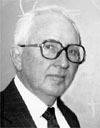CAMBRIDGE, Mass. -- Professor emeritus Patrick Leehey, who taught at MIT for 28 years following a 22-year career in the United States Navy during which he achieved the rank of captain, died of pancreatic cancer Monday night at home in Swampscott, Mass. He was 80 years old.
Born on Oct. 27, 1921 in Waterloo and raised in Oelwein, Iowa, Leehey attended the University of Iowa and the United States Naval Academy, graduating in 1942. During World War II, Leehey served aboard the battleships USS Washington and the USS Wisconsin. He participated in the Third battle of Savo Island, Nov. 15-16, 1942, and was in the Task Forces at Iwo Jima, and Okinawa. Leehey married the former Dorothy Irene Feltus of Oelwein on February 3, 1944 between tours of duty.
In 1945, Leehey participated in the bombardment of the Japanese mainland and was a member of the First Navy-Marine Corps landing party that went ashore at Yokosuka prior to Japanese surrender.
At the end of the war, Leehey attended the Naval Post-Graduate School at Annapolis and Brown University and earned a Ph.D. in applied mathematics from Brown in 1950. He served in the Mediterranean on board the cruiser USS Columbus during the Korean War.
Leehey played a major role in the development of Naval Hydrofoil craft at the office of Naval Research in Washington, served as design superintendent at the Puget Sound Naval Shipyard in Bremerton, Wash., from 1956 to 1958, and as head of the newly established Acoustics and Vibration Laboratory at the David Taylor Model Basin in 1963-64. In 1962 he received the Gold Medal Award of the American Society of Naval Engineers for his work in ship silencing.
Leehey was involved in the investigation of the disappearance of the nuclear submarine Thresher, which sank during a test dive off Nantucket in 1963 claiming the lives of all 129 on board. The investigation attributed the accident to a leak at a silver-brazed joint in an engine room seawater system that may have short-circuited electrical equipment.
Upon retiring from the Navy, Leehey came to MIT in 1964 as an associate professor in the Departments of Naval Architecture (changed to Ocean Engineering in 1971) and Mechanical Engineering. He founded the MIT Acoustics and Vibration Laboratory, which subsequently served as an interdepartmental focal point for research and education in acoustics.
Leehey, who was promoted to full professor in 1967, taught numerous graduate courses on flow noise, boundary layer theory, hydrofoil and propeller theory, acoustics, and structural vibration. He retired in 1992 but continued to teach, including an Edgerton Center seminar in digital and darkroom imaging which combined his computer skills and photography, a lifelong avocation.
He was an active member of the Whiting Club, the First Church in Swampscott, Congregational, and the Greater Lynn Photographic Association, and received numerous awards in local, regional and national competitions for his photographs. He served as the moderator at First Church from 1979 to 1981.
In addition to his wife, Leehey is survived by six children, Patrick, David, Christopher, Jonathan, Susan, and Jennifer; a brother, James; and seven grandchildren -- Rebecca, Edward, Anna, Jennifer, Katie, Annemarie and Emily.
Services will be held at the First Congregational Church, 40 Monument Avenue, Swampscott, at 10 a.m. Friday. Visiting hours on Thursday night are 7 to 9 p.m. at the Richardson Funeral Home, 48 Lafayette Park, Lynn. Burial will be at the Swampscott Cemetery. Donations may be made to the First Church Memorial Fund.






